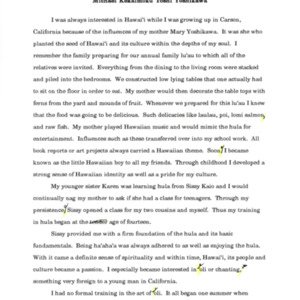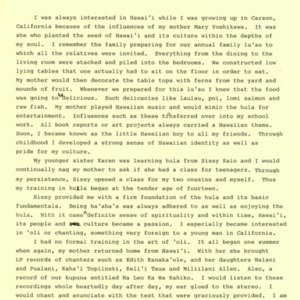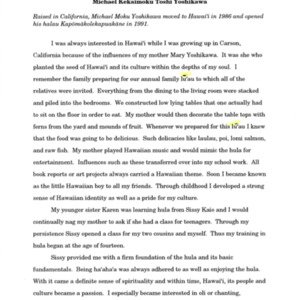Michael Kekaimoku Toshi Yoshikawa
Title
Michael Kekaimoku Toshi Yoshikawa
Subject
Michael Kekaimoku Toshi Yoshikawa
Description
Raised in California, “Moku” Yoshikawa moved to Hawaiʻi in 1986 and opened Kapōmākolekapuakāne in 1991.
I was always interested in Hawai‘i while I was growing up in Carson, California because of the influences of my mother Mary Yoshikawa. It was she who planted the seed of Hawai‘i and its culture within the depths of my soul. I remember the family preparing for our annual family lū‘au to which all of the relatives were invited. Everything from the dining to the living room were stacked and piled into the bedrooms. We constructed low lying tables that one actually had to sit on the floor in order to eat. My mother would then decorate the table tops with ferns from the yard and mounds of fruit. Whenever we prepared for this lū‘au, I knew that the food was going to be delicious. Such delicacies like laulau, poi, lomi salmon, and raw fish. My mother played Hawaiian music and would mimic the hula for entertainment. Influences such as these transferred over into my school work. All book reports or art projects always carried a Hawaiian theme. Soon I became known as the little Hawaiian boy to all my friends. Through childhood I developed a strong sense of Hawaiian identity as well as a pride for my culture.
My younger sister Karen was learning hula from Sissy Kaio and I would continually nag my mother to ask if she had a class for teenagers. Through my persistence Sissy opened a class for my two cousins and myself. Thus my training in hula began at the age of fourteen.
Sissy provided me with a firm foundation of the hula and its basic fundamentals. Being ha‘aha‘a was always adhered to as well as enjoying the hula. With it came a definite sense of spirituality and within time, Hawai‘i, its people, and culture became a passion. I especially became interested in oli or chanting, something very foreign to a young man in California.
I had no formal training in the art of oli. It all began one summer when again, my mother returned home from Hawaiʻi. With her she brought LP records of chanters such as Edith Kanaka'ole and her daughters Nalani and Pualani, Kalia'i Topolinski, Keli'i Tau‘a, and Mililani Allen. Also a record of our kupuna entitled “Na Leo Ka Wa Kahiko." I would listen to these recordings wholeheartedly day after day; my ear glued to the stereo. I would chant and enunciate with the text that were graciously provided. I am thankful for these recordings because they were my beginning.
Since I have moved to Hawaiʻi, I have studied briefly with Kalani Akana and I have always been supported by Uncle George Nā'ope of Hawai'i who came to California to give hula workshops.
In time I was appointed to alaka‘i of the men’s class and then became ho‘opa‘a because of my desire to chant. I was only eighteen. Experience would come in the form of trial and error, trusting the instinct within my na‘au. The men’s class became my responsibility to which Sissy herself would come watch and listen. She encouraged me to choreograph a mele or we would create in tandem. It was a relationship that lasted for a total of eight years. To this very day I still return to California and share what I have learned with Sissy and her hālau, an act that was bestowed upon me so freely and lovingly. We experienced many parties, shows, and competitions together as kumu and haumāna but my appetite to learn more about hula was voracious. In the summer of 1986 I moved to Hawai‘i and after settling in, an invitation came to join The Gentlemen of Maluikeao under the guidance of Palani Kahala. Thus began my training with Palani after receiving my blessings from Sissy to further my hula career.
Palani refined me. Being a very creative person, he always had a new idea or concept to execute. He challenged himself to different tangents in hula. A very contemporary style based on a strong knowledge of traditional values. Costuming was always impeccable and precise. He stressed the importance of learning the language and opened my sense of creativity, smoothing out all my rough edges. You will always see traces of Palani’s teaching within my choreographies as I mix his with mine.
I was training in ho‘opa‘a class when Palani became ill and so classes had to be postponed until he was in better health. Unfortunately we were unable to continue because of his untimely death. Prior to his passing Palani gathered four of his haumāna, Leimomi Cruz, Pomaika‘i Gaui, Ka‘ilipūnohu Canopin, and myself and gave us his blessings to begin our own halau. Later he sat me down in private, talking and instilling in me that the journey and responsibility that I would be undertaking is of great importance and that one day I would be a great hula teacher. It was a special moment for me and I knew it was his way of telling me that he would always be by my side. I will always remember him.
Palani was the one who gave me the name of my hālau. One day he came over to my apartment and said he had been dreaming of this Hawaiian name for three nights straight. He then said it was meant for me. The name that was given, Ka-pōmākole-kapu-a-kāne, means, “The Sacred Night Rainbow of Kāne. I gladly accepted his gift and he advised me to have the name blessed. This was done by my dear friend Richard Kamanu of Kaua‘i.
Within the last two years I have had the pleasure of being reunited with the Hawaiian side of the family. It was a childhood dream come true because I knew my talents just didnʻt come from nowhere. I knew that the knowledge of my Hawaiian ancestry would be revealed to me when the time was right. Upon meeting and spending time with them, I have found that there were and still are kumu hula within the family line and that hula and music are part of their everyday lives. Knowing this I have found the root from which I grow and it has given me just that much more mana to continue on. To my ‘ohana in Kohala and here on O'ahu, it has been my pleasure and honor to finally have placement with my kupuna.
My greatest accomplishments are not measured by physical things such as trophies and plaques but of growth within spirit and knowledge. If there was one thing that I could say to my haumāna and other kumu and their hālau, it would be “Kulia i ka nu‘u!” (Strive to reach the highest!)
116 Michael Kekaimoku Toshi Yoshikawawa
I was always interested in Hawai‘i while I was growing up in Carson, California because of the influences of my mother Mary Yoshikawa. It was she who planted the seed of Hawai‘i and its culture within the depths of my soul. I remember the family preparing for our annual family lū‘au to which all of the relatives were invited. Everything from the dining to the living room were stacked and piled into the bedrooms. We constructed low lying tables that one actually had to sit on the floor in order to eat. My mother would then decorate the table tops with ferns from the yard and mounds of fruit. Whenever we prepared for this lū‘au, I knew that the food was going to be delicious. Such delicacies like laulau, poi, lomi salmon, and raw fish. My mother played Hawaiian music and would mimic the hula for entertainment. Influences such as these transferred over into my school work. All book reports or art projects always carried a Hawaiian theme. Soon I became known as the little Hawaiian boy to all my friends. Through childhood I developed a strong sense of Hawaiian identity as well as a pride for my culture.
My younger sister Karen was learning hula from Sissy Kaio and I would continually nag my mother to ask if she had a class for teenagers. Through my persistence Sissy opened a class for my two cousins and myself. Thus my training in hula began at the age of fourteen.
Sissy provided me with a firm foundation of the hula and its basic fundamentals. Being ha‘aha‘a was always adhered to as well as enjoying the hula. With it came a definite sense of spirituality and within time, Hawai‘i, its people, and culture became a passion. I especially became interested in oli or chanting, something very foreign to a young man in California.
I had no formal training in the art of oli. It all began one summer when again, my mother returned home from Hawaiʻi. With her she brought LP records of chanters such as Edith Kanaka'ole and her daughters Nalani and Pualani, Kalia'i Topolinski, Keli'i Tau‘a, and Mililani Allen. Also a record of our kupuna entitled “Na Leo Ka Wa Kahiko." I would listen to these recordings wholeheartedly day after day; my ear glued to the stereo. I would chant and enunciate with the text that were graciously provided. I am thankful for these recordings because they were my beginning.
Since I have moved to Hawaiʻi, I have studied briefly with Kalani Akana and I have always been supported by Uncle George Nā'ope of Hawai'i who came to California to give hula workshops.
In time I was appointed to alaka‘i of the men’s class and then became ho‘opa‘a because of my desire to chant. I was only eighteen. Experience would come in the form of trial and error, trusting the instinct within my na‘au. The men’s class became my responsibility to which Sissy herself would come watch and listen. She encouraged me to choreograph a mele or we would create in tandem. It was a relationship that lasted for a total of eight years. To this very day I still return to California and share what I have learned with Sissy and her hālau, an act that was bestowed upon me so freely and lovingly. We experienced many parties, shows, and competitions together as kumu and haumāna but my appetite to learn more about hula was voracious. In the summer of 1986 I moved to Hawai‘i and after settling in, an invitation came to join The Gentlemen of Maluikeao under the guidance of Palani Kahala. Thus began my training with Palani after receiving my blessings from Sissy to further my hula career.
Palani refined me. Being a very creative person, he always had a new idea or concept to execute. He challenged himself to different tangents in hula. A very contemporary style based on a strong knowledge of traditional values. Costuming was always impeccable and precise. He stressed the importance of learning the language and opened my sense of creativity, smoothing out all my rough edges. You will always see traces of Palani’s teaching within my choreographies as I mix his with mine.
I was training in ho‘opa‘a class when Palani became ill and so classes had to be postponed until he was in better health. Unfortunately we were unable to continue because of his untimely death. Prior to his passing Palani gathered four of his haumāna, Leimomi Cruz, Pomaika‘i Gaui, Ka‘ilipūnohu Canopin, and myself and gave us his blessings to begin our own halau. Later he sat me down in private, talking and instilling in me that the journey and responsibility that I would be undertaking is of great importance and that one day I would be a great hula teacher. It was a special moment for me and I knew it was his way of telling me that he would always be by my side. I will always remember him.
Palani was the one who gave me the name of my hālau. One day he came over to my apartment and said he had been dreaming of this Hawaiian name for three nights straight. He then said it was meant for me. The name that was given, Ka-pōmākole-kapu-a-kāne, means, “The Sacred Night Rainbow of Kāne. I gladly accepted his gift and he advised me to have the name blessed. This was done by my dear friend Richard Kamanu of Kaua‘i.
Within the last two years I have had the pleasure of being reunited with the Hawaiian side of the family. It was a childhood dream come true because I knew my talents just didnʻt come from nowhere. I knew that the knowledge of my Hawaiian ancestry would be revealed to me when the time was right. Upon meeting and spending time with them, I have found that there were and still are kumu hula within the family line and that hula and music are part of their everyday lives. Knowing this I have found the root from which I grow and it has given me just that much more mana to continue on. To my ‘ohana in Kohala and here on O'ahu, it has been my pleasure and honor to finally have placement with my kupuna.
My greatest accomplishments are not measured by physical things such as trophies and plaques but of growth within spirit and knowledge. If there was one thing that I could say to my haumāna and other kumu and their hālau, it would be “Kulia i ka nu‘u!” (Strive to reach the highest!)
116 Michael Kekaimoku Toshi Yoshikawawa
Citation
“Michael Kekaimoku Toshi Yoshikawa,” Nā Kumu Hula Archive, accessed December 13, 2025, https://nakumuhula.org/archive/items/show/156.











